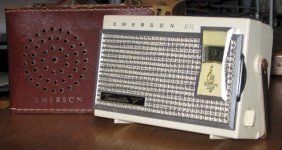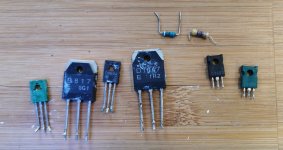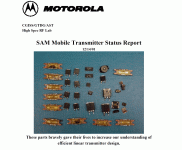I am about to finish the mod to an AudioTechnica headphone that was an RF wireless type. It was $4.00 at the Goodwill store with no transmitter. I opened it up, removed the radio boards, and installed a 3.5 MM jack on one side, then wired it directly to the transducers.
The jack failed due to insufficient depth to provide threads to screw the jack nut to. Replaced the jack and applied a dab of Duco type cement. Now it is firmly attached.
This headset has very comfortable ear cushions, good sound isolation, and sounds pretty darned good, especially considering the minimal investment made.
I'm going to "close" the operation right now.
The jack failed due to insufficient depth to provide threads to screw the jack nut to. Replaced the jack and applied a dab of Duco type cement. Now it is firmly attached.
This headset has very comfortable ear cushions, good sound isolation, and sounds pretty darned good, especially considering the minimal investment made.
I'm going to "close" the operation right now.
Then there's the lack of an operational or service manual, unfathomable theory(s) of operation, and the intermittent nature of a wide range of possible failure points. Truly a challengeI hate to generalize, but I think that's only when we don't listen / can't read their minds - they on the other hand can generally intuit what we're thinking
Repaired a flat tyre on my bicycle yesterday and managed to de-repair an XTC amp a week ago. Someone had fiddled with the amp, swapped some resistors and ruined the copper traces and wanted help to fix that. Then there was more - too high voltages and too much or too little bass . And while I was checking the resistors changed and that ran hot (though should just burn some 0.4W), I killed (I hope) a zenerdiode and maybe a transistor.
Today, I found my 6P45S amp was giving me less power than my 12GE5 amp. The cause was blocking distortion*. 330n got changed to 1uF to solve that.
Also one tube was weak. Three tubes biased around -72V, the fourth was around -61V... swapped it. Heard a pop. One tube then biased at -122V. Blown cathode resistor due to a bad tube (arc?)... Replaced that and the tube, all is well again.
I love my Modular Amplifier design universally, but I'm starting to settle on the *G**5 tubes for the outputs. Less power, but less hassle.
* If I understand correctly, if you turn it up to clipping for a few seconds, lower the volume, and it continues to be distorted for a couple of seconds, it's blocking, right? In any case, the larger cap sorted it.
Also one tube was weak. Three tubes biased around -72V, the fourth was around -61V... swapped it. Heard a pop. One tube then biased at -122V. Blown cathode resistor due to a bad tube (arc?)... Replaced that and the tube, all is well again.
I love my Modular Amplifier design universally, but I'm starting to settle on the *G**5 tubes for the outputs. Less power, but less hassle.
* If I understand correctly, if you turn it up to clipping for a few seconds, lower the volume, and it continues to be distorted for a couple of seconds, it's blocking, right? In any case, the larger cap sorted it.
Last edited:
Just finished restoring a 1964 Emerson 911 "Eldorado" 9 transistor AM portable radio.
Had poor reception near the lower part of the band.
This set has an RF amp stage, 3 IF stages, so it should pull in plenty of stations, which it does now.
I had to replace every stinkin' cap in the set, including the ceramic disks.
A representitive photo of the 911....
Had poor reception near the lower part of the band.
This set has an RF amp stage, 3 IF stages, so it should pull in plenty of stations, which it does now.
I had to replace every stinkin' cap in the set, including the ceramic disks.
A representitive photo of the 911....
Attachments
now that i likeJust finished restoring a 1964 Emerson 911 "Eldorado" 9 transistor AM portable radio.
Had poor reception near the lower part of the band.
This set has an RF amp stage, 3 IF stages, so it should pull in plenty of stations, which it does now.
I had to replace every stinkin' cap in the set, including the ceramic disks.
A representitive photo of the 911....
Your picture reminded me of the front cover of a report I wrote detailing the results of nearly a year's work by 9 people over 20 years ago. There were two of us who did the test board building, and often destructive testing. I lost the coin toss as to who had to write the 100 page report. I did not make all of the pretty Powerpoint slides though. This picture is a small sample of all of the silicon that we killed during that year. We blew up so many of the LDMOS RF devices (copper colored) that we didn't even put the lids on the custom packages that are seen in. Most of my patents are related to these unique RF "ring" packages. The unique variable power supply used was responsible for the dead mosfets.A NAD 3240pe-almost the whole output section gone-driven to almost destruction
all good now
Attachments
love the picture and captionYour picture reminded me of the front cover of a report I wrote detailing the results of nearly a year's work by 9 people over 20 years ago. There were two of us who did the test board building, and often destructive testing. I lost the coin toss as to who had to write the 100 page report. I did not make all of the pretty Powerpoint slides though. This picture is a small sample of all of the silicon that we killed during that year. We blew up so many of the LDMOS RF devices (copper colored) that we didn't even put the lids on the custom packages that are seen in. Most of my patents are related to these unique RF "ring" packages. The unique variable power supply used was responsible for the dead mosfets.
I've was given a pocket watch today that needed a new battery.
My pocket microscope reveals it was a tiny SR626. Apparently equivalent to a Kodak AG4:
https://www.batteriesinaflash.com/watch-battery-cross-reference
£1.50 for a job-lot at Poundland. Cheaper than £10-12 at the jewellers.
Did the pocket watch and the dress watch on the right.

Will research the 6 slot screw thread on the left-hand Ben Sherman, and the next Rotary, which lifts of with a blade, but experience tells me has a tricky rubber grommet to waterproof.

These things used to last 5 years, but now you get about 18 months.

Tricky things, batteries. So many types and thicknesses!
My pocket microscope reveals it was a tiny SR626. Apparently equivalent to a Kodak AG4:
https://www.batteriesinaflash.com/watch-battery-cross-reference
£1.50 for a job-lot at Poundland. Cheaper than £10-12 at the jewellers.
Did the pocket watch and the dress watch on the right.
Will research the 6 slot screw thread on the left-hand Ben Sherman, and the next Rotary, which lifts of with a blade, but experience tells me has a tricky rubber grommet to waterproof.
These things used to last 5 years, but now you get about 18 months.
Tricky things, batteries. So many types and thicknesses!
Seizaken (Seiko) 30p UK
Maxell 20p UK
Each, SR626SW
Retail to me
Shops pay half.
By the way, that is 6 mm diameter x 2.6 mm thick
CR 2032 is 20 mm diameter x 3.2 mm thick
....and so on.
Chinese LR 44 were 60p for 100 some years back, still must be less than 100p, that is right, 1 penny for a cell.
Maxell 20p UK
Each, SR626SW
Retail to me
Shops pay half.
By the way, that is 6 mm diameter x 2.6 mm thick
CR 2032 is 20 mm diameter x 3.2 mm thick
....and so on.
Chinese LR 44 were 60p for 100 some years back, still must be less than 100p, that is right, 1 penny for a cell.
There are Silver Oxide (longer lasting) & Alkaline (short life).
You pay your money.....
Fixed my bro's Hugo Boss 30mtr watch. Replaced battery & broken glass.
Original glass was ~1mm thick, dead flat & large 34mm dia - just asking to be broken.
Generic Ebay replacement was 1.5mm thick, bevelled edge - much stronger.
Turned a couple of anvils from mdf (one-time use) to support the watch back & press the glass.
Used the bench drill as a press.
Easy enough job though I'm not testing the water resistance.
I did make a key for the slotted back on a Rotary I used to have; from a couple of Meccano 147c Pawls connected by a couple of Strips.
You pay your money.....
Fixed my bro's Hugo Boss 30mtr watch. Replaced battery & broken glass.
Original glass was ~1mm thick, dead flat & large 34mm dia - just asking to be broken.
Generic Ebay replacement was 1.5mm thick, bevelled edge - much stronger.
Turned a couple of anvils from mdf (one-time use) to support the watch back & press the glass.
Used the bench drill as a press.
Easy enough job though I'm not testing the water resistance.
I did make a key for the slotted back on a Rotary I used to have; from a couple of Meccano 147c Pawls connected by a couple of Strips.
nothing lasts anymore, not like years agoI've was given a pocket watch today that needed a new battery.
My pocket microscope reveals it was a tiny SR626. Apparently equivalent to a Kodak AG4:
https://www.batteriesinaflash.com/watch-battery-cross-reference
£1.50 for a job-lot at Poundland. Cheaper than £10-12 at the jewellers.
Did the pocket watch and the dress watch on the right.
View attachment 1040090
Will research the 6 slot screw thread on the left-hand Ben Sherman, and the next Rotary, which lifts of with a blade, but experience tells me has a tricky rubber grommet to waterproof.
View attachment 1040092
These things used to last 5 years, but now you get about 18 months.
View attachment 1040094
Tricky things, batteries. So many types and thicknesses!
EXACTLY!There are Silver Oxide (longer lasting) & Alkaline (short life).
You pay your money.....
I got tired of the Alkalines for watches, etc.
They don't last!
Got the Silver Oxide..... and what a blessed difference!
Now you know why most of my stuff is "vintage".nothing lasts anymore, not like years ago
I frown on having to replace things, particularly cheap crap.
CR2032 Lithium BIOS batteries last a decade in my experience.
Actually it was a SR626SW in the pocket watch. I didn't think the SW mattered, but it is better than the SR626.
Well, Thank you folks! So SR44 is a good silver oxide calculator battery. LR44 is the poorer alkaline equivalent. Curiously, my Casio Calculator went a decade on what I think was an LR44.
The Ben Sherman lasted about 5 years on the original battery. The £10 and £12 fix-it shops ones lasted 18 months.
What a racket! They keep you coming back! And save pennies...
Actually it was a SR626SW in the pocket watch. I didn't think the SW mattered, but it is better than the SR626.
Well, Thank you folks! So SR44 is a good silver oxide calculator battery. LR44 is the poorer alkaline equivalent. Curiously, my Casio Calculator went a decade on what I think was an LR44.
The Ben Sherman lasted about 5 years on the original battery. The £10 and £12 fix-it shops ones lasted 18 months.
What a racket! They keep you coming back! And save pennies...
Still have my well functioning 1984 Texas Instruments TI-34 SOLAR POWERED calculator. I'm very careful not to drop it or abuse it in any way. I've got an arrangement of stuff needing these " watch batteries"...would like to get that laser up & running again? My 'old' DVOM finally couldn't deal with the leaking electrolyte, seems like it ate up some traces. I'm hesitant to buy a new one...knowing it likely will fail inside a year or two. Guess I'll keep using that old pocket analogue.
-----------------------------------------------------------------------------------------------------------------------------------Rick...
-----------------------------------------------------------------------------------------------------------------------------------Rick...
- Home
- Member Areas
- The Lounge
- What did you last repair?


